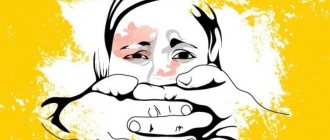Although the term “identity” has become ingrained in our everyday language, it remains vague and undefined. Indeed, various social sciences have attempted to describe what the concept of identity entails.
There is a general consensus that identity is not given by nature, but is the subject of a continuous process, consciously or unconsciously shaped and influenced: first you become who you are.
This process is never complete, and a person's identity is always temporary and fragile.
Particularly in a crisis situation, it may happen that someone doubts their identity, feels disoriented and unsure of themselves and their position in society.
A general definition of identity can be derived from this knowledge: identity means being oriented, knowing one's own position in everyday life, in one's surroundings and in the world. The definition of identity serves to represent oneself and others. Each “I am” always implicitly contains a difference or distinction from the “other.”
What is identity? Definition
The term “identity” can be understood as the answer to the question, who are you? (or someone else). Identity in the psychological sense answers the question of the conditions that create life-historical and cross-situational equality in perception, making it possible for oneself (internal uniformity, despite external changes).
Psychology thus took up the philosophical question that Plato had formulated in a classical way. In his dialogue "Symposium" he allows Socrates to speak as follows:
“...every single living being, while it lives, is considered and called the same: for example, a person is considered the same from infancy to old age. But although he bears the same name, he never remains the same in himself, but, on the one hand, he is constantly renewed, on the other, he loses other things: hair, flesh, bones, blood and his entire bodily organism. And this applies not only to the body, but also to the soul: character traits, habits, opinions, desires, joys and sorrows, fears: all this never remains unchanged for every person. But one thing arises, another passes away"
Plato
Concept of identity
Identity is a set of characteristics by which a person or element can be easily identified or distinguished. This may have certain variations or modifications depending on experience, experience and even age. From these variables, identity types emerge.
Identity is an act of social construction: one's own identity or another identity is captured in a network of meanings. The question of identity has a universal and culturally specific dimension.
It is always about creating a correspondence between the subjective “internal” and the social “external”, that is, about creating an individual social location.
Identity formation
The need to build individual identity refers to the basic human need for recognition and belonging. It is anthropologically identified as an "inferior being", a subject of self-positioning, allowing with an individual sense of determination for the individual.
Identity forms a reflexive loop between the inner and outer world. It is in this function that the dual character of identity becomes visible: on the one hand, it must make the unmistakably individual, but also the socially acceptable, representative. In this regard, he always represents a compromise between stubbornness and adaptation. The issue of “equality in diversity” also dominates contemporary theories of identity.
Formation goes through 8 stages:
Identity structure
The structure of any identity is divided into three stages:
1. Original
2. Derivative
3. Final
Bodily criterion
The bodily criterion represents another theory, according to which until the moment that the physical being that is a person retains its form, a person remains a person.
Supporters of this position agree that personality is only a physically conditioned idea, and it is this idea that is the only component that is required for a person to remain himself. If (when) the existence of the physical body ceases, then (then) the existence of the personality will cease, and self-identification will become impossible.
Types of Identity
Identity types are classifications into which social groups are found. These include age identity, cultural identity, racial identity, relationship identity, political identity, religious identity, socioeconomic status identity, gender and sexual identity, professional identity, corporate identity, etc.
Gender identity
Gender identity is how a person sees themselves, such as: woman, man, transgender/gender queer, a combination, or none of these categories.
Gender identity
A person's gender is an identity that may or may not conform to generally accepted expectations of sex at birth. For example, a person may be assigned male gender at birth, but with a female identity. This may be a feeling of belonging to a man, a woman or another gender.
Sexual identity
Sexual orientation identity is defined as an emotional, romantic, sexual, spiritual, affective identity and/or attraction to another person or people. This may include a person's fantasy, behavior and personal identification, composition or general disposition in terms of mating attraction.
Sexual orientation develops through a multi-step process and can change over time. Sexual orientation is not necessarily related to a person's gender identity. These two concepts may have nothing in common with each other. Sexual orientation identities may include: gay, lesbian, straight, queer, bisexual, pansexual, transgender, etc.
Ethnic identity
It refers to membership in an ethnic group based on the genealogy or ancestors common to people. In this case, people are usually united by most things: culture, language, religion and customs.
National identity
It refers to the feeling of belonging to a nation or country. It has similarities to cultural identity, but it is actually more rooted in national sentiment, as the people of a country may meet on a particular day to commemorate the anniversary of independence, revolution, or simply the country in which they live.
Professional identity
It is a career or profession of which we are a part and in which we are accompanied by people with the same calling. Here we collect our knowledge, the values with which we work, and the responsibilities assigned to us.
Cultural identity
It is defined in terms of culture, language and country of origin. It refers to a person or large group of people who share a national, cultural and/or linguistic heritage, whether or not they reside in their countries of origin.
Civilizational identity
This is the relationship of oneself with history, development, culture, etc. of your state. Formation of the concept - Motherland. The formation of this identity is one of the priority goals of education at the state level, which is also a necessity for the development of the state.
Group and ego identity
Continuity and stability of one's own "I" and a subjective sense of integrity - ego identity.
The feeling of belonging to one of the social groups is group identity.
Both of these identities are formed during life and consciously.
Forbidden:
- Appeal to the child’s feelings - “don’t be upset, it’s not as serious as you think”, “don’t cry, it doesn’t hurt!”
- Address the gender of the child - “don’t cry, you’re a boy!”, “be strong, you’re a modern girl!”
- Address the child’s age - “you’re already 16, but you can’t solve this issue yourself!”, “When you grow up, you’ll understand more!”
Loss of identity
Loss of identity can occur at any age. It occurs when a person discovers huge differences between how a person feels and would like to be and who he actually is. This primarily concerns our experience, because the main difference between a person and others is his experience.
Causes
- Unexpected changes
Changes such as bereavement due to a significant and unexpected loss, divorce, layoff, displacement due to a job change, or other factors, among others, are often “triggers” for loss of identity.
- Adolescence stage
This stage is sensitive due to the constant and profound physical, mental and psychological changes that occur during the intermediate phase of childhood or adulthood.
Therefore, it can cause a loss of identity as the person has to develop a new identity and will rely on their peer groups to do so.
- Lack of self-knowledge
If a person does not understand his personal values and is faced with a situation in which he must make an important decision for his life, realizing that he does not really know himself, he enters into a conflict that can cause a loss of identity.
Symptoms and signs
Loss of identity causes a number of symptoms. However, you need to keep in mind that all the symptoms may vary from one person to another:
- feeling lost;
- feeling of loneliness and emptiness;
- problems with decision making because there are no firm or defined criteria;
- anxiety;
- difficulty solving problems;
- emotional instability;
- a feeling of lack of ability or preparation for change and new cycles.
Danger of condition
All of this can have consequences that not only affect the mental health of those who suffer from it, but can also pose risks to physical and emotional health.
For this reason, it is recommended that if such a condition is detected, you seek help from a professional who can diagnose and apply effective treatment.
What to do?
To overcome them, you shouldn’t resort to self-help phrases like “happiness is in you” or “if you want it, you can do it.” In some cases, a process of acceptance is required in which a person is able to accept that he cannot achieve his goal or life goal. In other cases, therapy attempts to provide a way to redirect a person's life. Counseling work can be aimed at eliminating many prejudices.
A visit to a psychologist will help you acquire tools that will later be useful in life.
Communication is the right way!
Speech is an excellent tool that allows you to approach an exciting issue competently and methodically. In addition, it is necessary to teach a child to understand personal emotions and states so that in the end he does not begin to be afraid to show his emotions .
Children whose parents forbid them to express their feelings grow up secretive. Throughout their adult lives, older children are haunted by the fear of showing their real emotions. Such a person will be very unhappy in life.
Talk to your child, be interested, listen, observe what emotional changes and outbursts your child experiences. Be sensitive. Don’t ask routine questions about school, maintain a full conversation, share your warmth with him, tell him how dear he is to you. And be sure to say “Good morning!” and good night!".
Identity crisis
An identity crisis is known as a period when a person experiences a series of deep self-doubts.
These doubts are characterized by doubt about the meaning of existence and are accompanied by a feeling of emptiness and loneliness.
This creates a feeling of anxiety as a person tries to redefine who they are and what vital moment they are at.
Identity crisis is divided into two types:
- Identity deficit occurs when a person has difficulty making important decisions. The person rejects values or goals and harbors feelings of insecurity and emptiness. They are very sensitive to the influence of other people.
- Identity conflict is the incompatibility of two or more aspects of identity. This type of crisis often occurs during periods when a person is forced to make an important and difficult life decision. A person who wants to achieve two conflicting goals at the same time. This crisis is often accompanied by feelings of guilt or remorse.
Identity is a complex and controversial issue because it is not clearly defined, whether it can be created by choice or is a concept that is imposed on society in order to become part of something larger. After all, knowing the idea of identity gives us the tools we need to discover who we are and who we want to be.
Natalia Shakhova
Parental responsibility.
- Parents should instill initiative and independence in their children.
- Consider issues that concern the child.
- Develop talents and abilities.
- Refuse to impose your opinions and views on life.
- Develop responsibility with the ability to make independent decisions.
- Accept the transition of a teenager to adulthood as an immutable fact.
- The time period of the crisis is individual for everyone. Some teenagers quickly form ideas about their own place in the world around them, while others solve this problem within a decade.
Whatever happens, don’t use insults!











